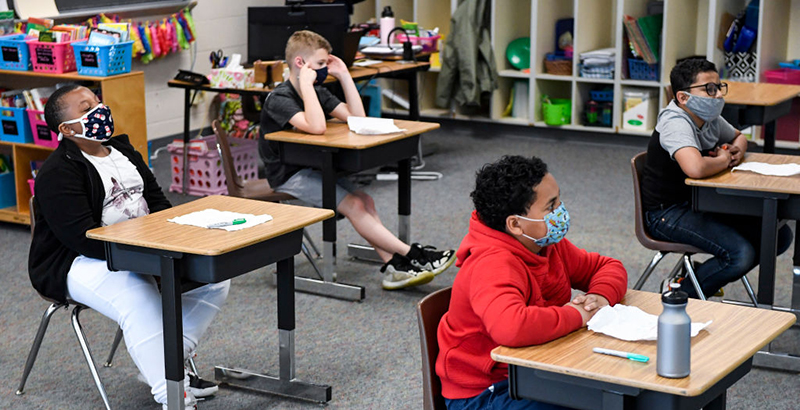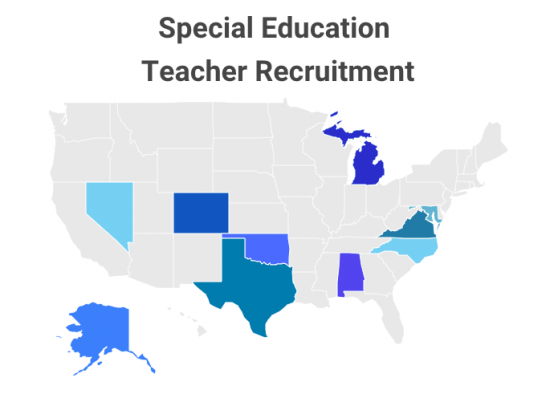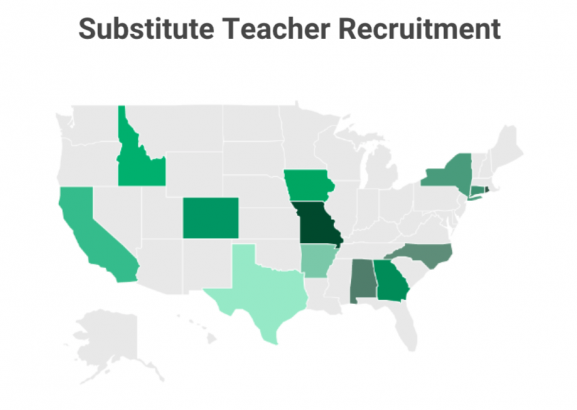Four-Day Work Weeks, Big Signing Bonuses and Paid Moving Expenses: See How Districts Across the U.S. Are Luring Subs, Special Ed Teachers

Get stories like this delivered straight to your inbox. Sign up for The 74 Newsletter
Confronting classrooms without permanent teachers, school administrators across the country are turning to an assortment of incentives — many of them financial, some unprecedented — to fill widespread vacancies.
Some districts are offering thousands in signing bonuses, others adapt to four-day work weeks and many are easing the way for college students or other would-be teaching candidates to get quickly certified.
In 2018, the National Bureau of Labor Statistics estimated 270,000 teachers would leave the profession annually through 2026 — a number that did not take into account the pandemic’s effects on teacher retention and retirement. A 2020 poll of educators revealed that almost a third nationwide would likely retire early or leave the profession because of the pandemic. Yet the bureau’s recent job data shows that actual teacher turnover levels are similar — and in some cases lower — than pre-pandemic levels. The estimated outcomes from alarming polls, suggesting that teachers everywhere would imminently leave the profession, have not necessarily come to fruition.
Retirement and attrition do vary greatly by county or state — Arizona saw about 200 more teachers leave by the end August 2020 than in 2019 or 2018, while Minnesota experienced the opposite effect — and there’s still much to be understood about the full scope of how the pandemic has affected the teaching force. At the same time, we do know that fewer adults are heading into teacher residencies and degree programs.
The lengths that some school and state leaders are going to to fill current vacancies, especially for special education and substitute teachers, does demonstrate that districts are seeing urgent staffing needs and are getting creative to meet them.
Accelerated licensure programs and alternatives for state teaching exams are popping up across the country to urgently meet students’ needs. Houston, for instance, had over 400 teacher openings as of mid-August; some may be filled by candidates still earning certifications.
Though places like metro Atlanta aren’t experiencing the same levels of staff scarcity, they are still offering a $5,000 sign-on incentive for special education teachers. Greater Atlanta’s DeKalb County Schools are also recruiting parents for full-time positions.
Out West, a bill in Colorado aims to transform the educator pipeline by recruiting high school students into teacher programs, former military personnel and adjunct professors. Nevada’s Carson City Schools will hire retired public employees to fill special education vacancies, and others in California are adopting the strategy of recruiting teachers where they’ve grown up, incentivizing staying in-state for higher education or pursuing teaching residencies in their home districts.
One Texas superintendent framed staffing challenges as a human capital problem, not a financial one. To aid schools’ pandemic recovery, millions in unprecedented federal relief funds are on their way to states. Only a handful included teacher recruitment or retention strategies in their budget proposals; nationwide, priorities for the relief funds are expanding academic tutoring and mental health care.
And critical shortages go beyond the classroom — hundreds of schools are hard-pressed to find bus drivers, after many have retired or decided to not risk COVID-19 exposure. Up to 250 National Guard service members will drive students to school in Massachusetts, and school leaders in Philadelphia are encouraging their governor to consider the same. Efforts to engage the National Guard in New York were rejected by Gov. Kathy Hochul; a spokesperson for her team said school transportation was “outside [their] current scope.”
In Chicago, where drivers are leaving en masse after the district mandated staff vaccines, some families of students with disabilities were given two days to find alternative transportation for the first day of school.
Students and families across the country are feeling the impacts of missing critical staff as the 2021-22 school year and quarantines get underway.
We’ve compiled some of the special education and substitute teacher recruitment efforts currently in effect:
Special Education Teacher Recruitment
All but six states reported teacher shortages in special education in the 2020-21 school year.
“We beg, borrow and steal wherever we can to find some good quality special education teachers for our district,” said Carson City Schools Superintendent Jose Delfin. The schools chief spoke during a school board meeting where the district designated the labor shortage as critical, enabling the hiring of retired public employees.
And while advocates have sounded the alarm on a declining special education force for years, states like Alaska have just established recruitment and retention task forces.
Click here if you cannot access the interactive version of this map.
Substitute Teacher Recruitment
Schools across the country employ between 500,000 and 600,000 subs annually, according to the National Bureau of Labor Statistics. School administrators in central Massachusetts say substitute applications have trickled to a stop. For smaller districts in California with teachers heading into COVID-19 quarantines, declining substitute teacher pools could force school closures.
In Idaho, Gov. Brad Little is encouraging workers statewide to fill shortages, “I urge Idahoans in a position to serve as a substitute teacher or other classroom support staff to contact your school district and get signed up. Idaho students and our communities need you.”
Click here if you cannot access the interactive version of this map.
Get stories like these delivered straight to your inbox. Sign up for The 74 Newsletter

;)


